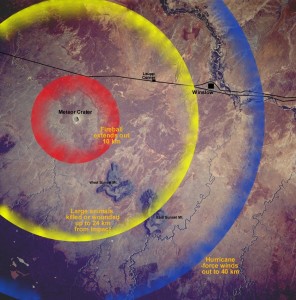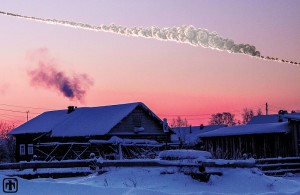
Artwork of Barringer Meteor Crater shows the range of environmental effects created by the impact. Credit: David A. Kring

Chelyabinsk sky rendering is a reconstruction of the asteroid that exploded over Chelyabinsk, Russia on Feb. 15, 2013. Scientific study of the airburst has provided information about the origin, trajectory and power of the explosion. This simulation of the Chelyabinsk meteor explosion by Mark Boslough was rendered by Brad Carvey using the CTH code on Sandia National Laboratories’ Red Sky supercomputer. Andrea Carvey composited the wireframe tail. Photo by Olga Kruglova. Credit: Sandia National Laboratories.
Prominent astronauts are taking part in a B612 Foundation event today at the Museum of Flight in Seattle, Wash. They are spotlighting data showing the surprising frequency at which the Earth is hit by asteroids.
The findings are based on newly released information from the Nuclear Test Ban Treaty Organization, which operates a network of sensors that monitors Earth around the clock listening for the infrasound signature of nuclear detonations.
Between 2000 and 2013, this network detected 26 explosions on Earth ranging in energy from 1 to 600 kilotons — all caused not by nuclear explosions, but rather by asteroid impacts.
While most of these asteroids exploded too high in the atmosphere to do serious damage on the ground, the evidence is important in estimating the frequency of a potential “city-killer-size” asteroid.
Blind luck
“While most large asteroids with the potential to destroy an entire country or continent have been detected, less than 10,000 of the more than a million dangerous asteroids with the potential to destroy an entire major metropolitan area have been found by all existing space or terrestrially-operated observatories,” observes Ed Lu, former U.S. shuttle astronaut and co-founder and CEO of the B612 Foundation.
“Because we don’t know where or when the next major impact will occur, the only thing preventing a catastrophe from a ‘city-killer’ sized asteroid has been blind luck,” Lu noted in a press statement.
The Earth is continuously colliding with fragments of asteroids, the largest in recent times exploding over Tunguska, Siberia, in 1908 with an energy impact of 5-15 megatons.
Recent events
More recently, is the air bursting event over Chelyabinsk, Russia in 2013. Asteroid impacts greater than 20 kilotons occurred in South Sulawesi, Indonesia, in 2009, in the Southern Ocean in 2004, and in the Mediterranean Sea in 2002.
Important to note about these recent events is that none of these asteroids were detected or tracked in advance by any existing space-based or terrestrial observatory.
The B612 Foundation aims to change that by building the Sentinel Space Telescope Mission, an early warning infrared space telescope for tracking asteroids that would provide many years to deflect an asteroid when it is still millions of miles away. The group is working with Ball Aerospace to construct Sentinel.
Privately funded
The B612 Sentinel Mission will be the world’s first privately funded deep space mission that will create the first comprehensive dynamic map of our inner solar system, identifying the current and future locations and trajectories of Earth crossing asteroids.
Sentinel will detect and track more than 200,000 asteroids in just the first year of operation, after a planned launch in 2018.
Joining Lu today to discuss the evidence for 26 atomic bomb scale asteroid impacts since 2000 is former NASA astronaut Tom Jones, President of the Association of Space Explorers and Apollo 8 astronaut Bill Anders.
Note: Video visualization of these findings, showing the impact size range and location of all 26 explosions can be viewed at:
https://b612foundation.org/portfolio/impact-video
A listing of all locations and size of impacts with additional FAQs can be found at:
https://b612foundation.org/impact-video-faq
By Leonard David
